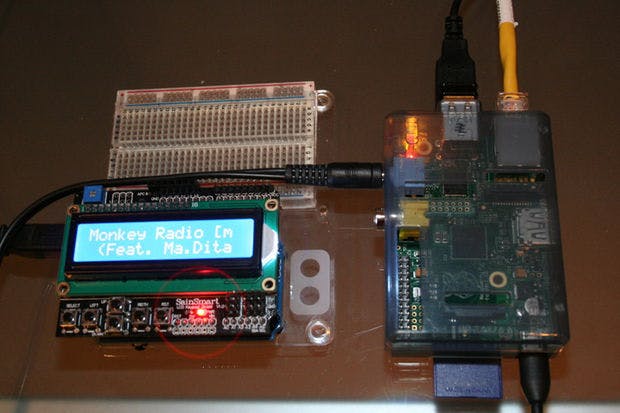This is a project for Arduino and Raspberry Pi to make an Internet Radio, aimed at intermediate skill level. Some familiarity with Linux usage will be beneficial (or access to someone who can help out if required).

Raspberry Pi runs mpd music player daemon to receive and decode the internet radio stream.
ALSA running on the Raspberry Pi provides the sound through either the Jack Socket or the HDMI output.
Arduino runs a nanpy interface code to interface with Python, providing Text output of the Radio Station playing and Button inputs to control Playback.
Objectives:
- Learn how to use the mpd/mpc on the Raspberry Pi
- Learn how to use the nanpy library for Python to interface the Pi to the Arduino
- Make a Cool Internet Radio
Install the Required Packages for mpd/mpc
The first thing we have to do is update Raspbian and install the required packages. Make sure you’re logged in (obviously), and you have an Internet connection.
1. Update Raspbian to the latest packages
$ sudo apt-get update
2. Install the mpd / mpc packages
$ sudo apt-get install mpc mpd
This installs the Music Player Daemon (mpd) and it’s client mpc.
You use the mpc client to configure mpd to add radio streams to the playlist, start and stop the player etc.
Install the Required Packages for Python-nanpy
We want to be able to talk to Arduino from Python running on the Pi.
To do that, we need to install the nanpy library for Python and the nanpy firmware for Arduino.
1. Install Arduino packages to build the nanpy firmware for Arduino
$ apt-get install arduino
2. Get the nanpy library for Python and extract
from /home/pi
$ wget http://pypi.python.org/packages/source/n/nanpy/nanpy-v0.7.tar.gz$ tar xvf nanpy-v0.7.tar.gz
3. Get setuptools for Python (a dependancy for nanpy) and extract
$ wget http://pypi.python.org/packages/source/s/setuptools/setuptools-0.6c11.tar.gz#md5=7df2a529a074f613b509fb44feefe74e$ tar xvf setuptools-0.6c11.tar.gz
4. Get pyserial for Python (a dependancy for nanpy) and extract
$ wget http://pypi.python.org/packages/source/p/pyserial/pyserial-2.6.tar.gz$ tar xvf pyserial-2.6.tar.gz
5. Go to the setuptools directory and install Python setuptools
$ cd setuptools-0.6c11$ sudo python setup.py install
6. Go to the nanpy directory and install the Python nanpy library
$ cd ../nanpy$ sudo python setup.py install
7. Go to the serial directory and install the Python serial library
$ cd ../pyserial-2.6 $ sudo python setup.py install
Now we’ve got the files we need let’s put the nanpy firmware on the Arduino.
Put the nanpy Firmware on the Arduino
nanpy allows a Python program runing on the raspberry Pi to operate the Arduino using conventional Arduino-Sketch syntax e.g. the Python program to read an analogue input from Arduino might read:
int val = Arduino.analogRead(14)
nanpy has two components:
i) a library for Python that allows Arduino commands to be written in a familiar syntax and communicate with Arduino;
ii) firmware that runs on Arduino, communicating with Python on the Pi
We installed the Python part of nanpy, and downloaded the Arduino part of nanpy on the Pi in the last step.
Now we need to upload the nanpy firmware to Arduino.
Plug Arduino into the USB of the Raspberry Pi.
1. Go to the nanpy firmware directory and upload to Arduino
$ cd ../nanpy/firmware$ export BOARD=uno$ make$ make upload
If you get a report that the device is not found on /dev/ttyACM0 , plug the Arduino into the other USB port.
